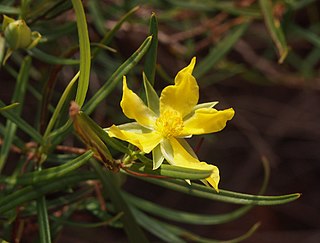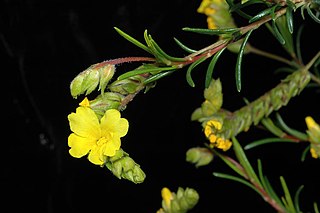
Darwinia, sometimes commonly known as mountain bells or simply bells, is a genus of about 70 species of evergreen shrubs in the family Myrtaceae, endemic to southeastern and southwestern Australia. The majority are native to southern Western Australia, but a few species occur in South Australia, New South Wales and Victoria. The genus was named in honour of Erasmus Darwin, grandfather of Charles Darwin by Edward Rudge in 1816. Most darwinias grow to a height of between 0.2 and 3 m, and many are prostrate shrubs. Most have small, simple leaves and the flowers are often grouped together, each flower with five red, white or greenish petals and ten stamens. In many species, the flowers are surrounded by large, colourful bracts, giving rise to their common names.

Hibbertia, commonly known as guinea flowers, is a genus of flowering plants in the family Dilleniaceae. They are usually shrubs with simple leaves and usually yellow flowers with five sepals and five petals. There are about 400 species, most of which occur in Australia but a few species occur in New Guinea, New Caledonia, Fiji and Madagascar.

Hibbertia scandens, sometimes known by the common names snake vine, climbing guinea flower and golden guinea vine, is a species of flowering plant in the family Dilleniaceae and is endemic to eastern Australia. It is climber or scrambler with lance-shaped or egg-shaped leaves with the narrower end towards the base, and yellow flowers with more than thirty stamens arranged around between three and seven glabrous carpels.

Hibbertia sericea, commonly known as silky guinea-flower, is a species of flowering plant in the family Dilleniaceae and is endemic to south-eastern Australia. It is an erect or spreading shrub with softly-hairy branches, elliptic to egg-shaped leaves with the narrower end towards the base, and yellow flowers with eight to fourteen stamens in a cluster on one side of two hairy carpels.

Hibbertia hypericoides, commonly known as yellow buttercups, is a species of flowering plant in the family Dilleniaceae and is endemic to the south-west of Western Australia. It is usually a spreading shrub with linear to elliptic or egg-shaped leaves, and yellow flowers, usually with ten to fifteen stamens arranged in a cluster on one side of the two densely hairy carpels.

Hibbertia grossulariifolia is a species of flowering plant in the family Dilleniaceae and is endemic to the south-west of Western Australia. It is a prostrate shrub that spreads up to 1.2 m in diameter and has yellow flowers that appear between August and December in the species' native range.

Hibbertia fasciculata is a species of flowering plant in the family Dilleniaceae and is endemic to south-eastern Australia. It is a small erect to spreading shrub with glabrous stems except on new growth, narrow linear leaves, and yellow flowers arranged in leaf axils, with eight to twelve stamens surrounding three carpels.

Hibbertia riparia, commonly known as erect guinea-flower, is a species of flowering plant in the family Dilleniaceae and is endemic to the south-eastern Australia. It is an erect to spreading shrub with hairy foliage, linear leaves and yellow flowers with six to sixteen stamens in a single cluster on one side of two carpels.
Lambertia fairallii, commonly known as Fairall's honeysuckle, is a shrub which is endemic to the south-west of Western Australia.

Johnsonia pubescens, commonly called the pipe lily, is a grass-like plant in the family Asphodelaceae, subfamily Hemerocallidoideae, endemic to the south-west of Western Australia. As with others in the genus, it is distinguished by its minute flowers which are on the end of a spike and hidden by large, overlapping, papery bracts.

Scaevola canescens is a species of plant in the family Goodeniaceae. It is endemic to Western Australia where it occurs "from Shark Bay to Perth, in open forest and heath in sandy soil".
Hibbertia atrichosepala is a species of flowering plant in the family Dilleniaceae and is endemic to a restricted area in the south-west of Western Australia. It is an upright shrub with crowded linear to tapering leaves and yellow flowers arranged singly in leaf axils with glabrous sepals and the five stamens all on one side of the two carpels.

Hibbertia commutata is a species of flowering plant in the family Dilleniaceae and is endemic to the south-west of Western Australia. It is a low, erect, many-branched shrub with narrow elliptic to narrow egg-shaped leaves, and yellow flowers with fifteen to thirty stamens arranged around three carpels.

Scaevola acacioides, is an erect, spreading shrub in the family Goodeniaceae.

Hibbertia subvaginata is a species of flowering plant in the family Dilleniaceae and is endemic to Western Australia. It is a small shrub that has yellow flowers with stamens arranged around three or four carpels.

Hibbertia glaberrima is a species of flowering plant in the family Dilleniaceae and is endemic to Central Australia. It is a glabrous, spreading shrub with oblong to lance-shaped leaves and yellow flowers borne singly in upper leaf axils, with 30 to 150 stamens arranged around three carpels.
Hibbertia helianthemoides is a species of flowering plant in the family Dilleniaceae and is endemic to a small area in the south-west of Western Australia. It is a prostrate to low-lying, spreading to erect, hairy shrub with hairy foliage, linear leaves and yellow flowers with thirteen stamens.
Hibbertia nutans, commonly known as nodding guinea flower, is a species of flowering plant in the family Dilleniaceae and is endemic to the south-west of Western Australia. It is an erect shrub that typically grows to a height of 0.2–1.0 m and flowers between August and October producing yellow flowers. It was first formally described in 1863 by George Bentham in Flora Australiensis from specimens collected in 1843 by James Drummond in the Swan River Colony. The specific epithet (nutans) means "nodding".

Hibbertia spicata is a species of flowering plant in the family Dilleniaceae and is endemic to the west of Western Australia. It is a low, erect to spreading shrub with scattered linear leaves with the edges rolled under and yellow flowers with six or seven stamens on one side of two softly-hairy carpels, and a larger number of staminodes.

Hibbertia mylnei is a shrub in the Dilleniaceae family, native to Western Australia. It was originally described by George Bentham in 1863. The plant's yellow flowers are seen in July to September.
















